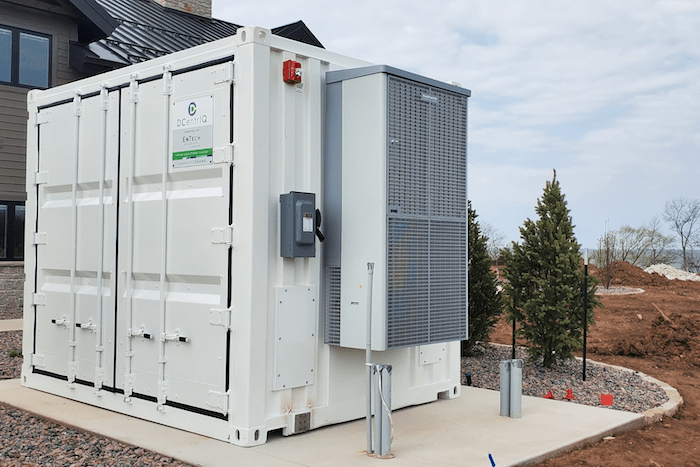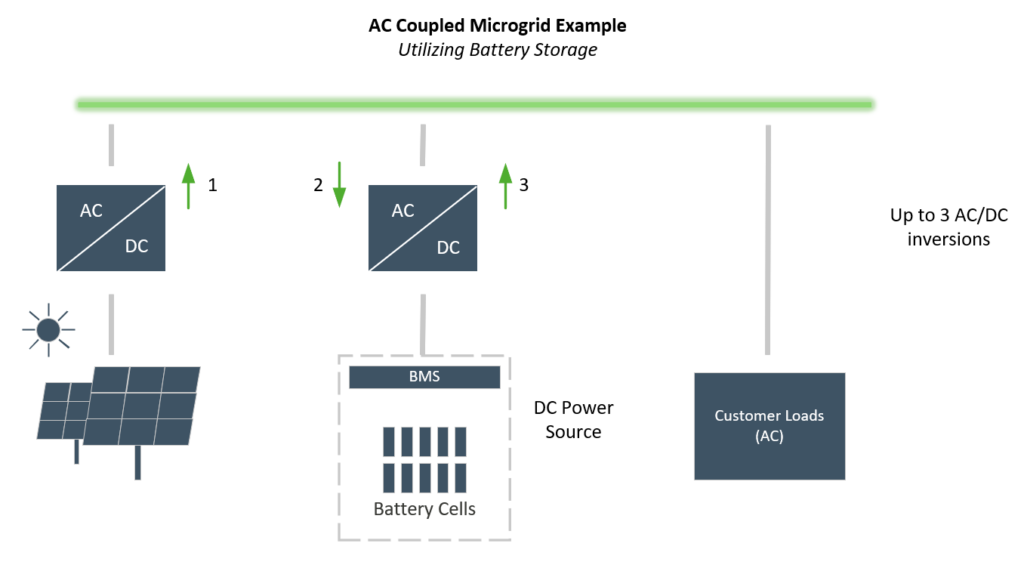
I’ve picked up an unexpected and exciting side gig at EnTech Solutions: tour guide! I enjoy the opportunity to host visitors and events at our microgrid sites; every group has been engaging, with people asking great questions. One topic that we spend ample time on is the difference between an alternate current (AC) coupled microgrid and a direct current (DC) coupled microgrid. Frequent questions include: What is meant by coupled? Why not stay with all one type of current, AC or DC? What are the benefits of switching to a less traditional DC-coupled microgrid?
To answer these questions, it helps to walk through the design process of microgrids. It begins with constraints that start with the components where we do not have a choice. Solar panels are included on most of our microgrids to provide a renewable generation source. All solar panels start DC-based; physics gets in the way of producing an AC solar cell. When we design a microgrid, we can choose to add an inverter to solar panels, which converts DC to AC, or we can choose to use a DC/DC converter which adjusts the DC voltage from the solar panels to the desired DC voltage.

Batteries are another common item used in microgrids. Solar energy is renewable but not always available; batteries are used to store excess solar energy for future use. All battery cells are DC sources; again, physics is in the way of an AC battery cell being developed. Same as with solar panels, we can choose to convert the DC from the battery to AC or keep it as DC.

Whether it is a DC-coupled or AC-coupled microgrid, there will be a variety of each type of current on the microgrid. The difference is what type of current is used to connect all the components together.
As I lead tours through the DC-coupled off-grid system at our Lakeside Vision Center, I cover the following benefits that led us to choose a DC-coupled design for the facility:
- Efficiency: Each conversion between AC and DC is less efficient than a DC/DC voltage change. The example below shows a solar and battery microgrid configured to store excess solar energy in batteries. The energy is later discharged from the batteries when solar is not available such as overnight or during cloudy weather. In a DC-coupled system, there is only one inversion between AC and DC. In an AC-coupled system, three inversions are required!


- Control: In an AC-coupled microgrid, the most common method to balance generation sources and loads is to use a central controller that connects to every device in the system. The controller monitors each device, calculates how to balance overall load and generation, and sends commands back to each device. However, even with fast communications and a fast central controller, this process takes time. Our challenge in microgrids is that electrical energy moves at near the speed of light. Unfortunately, changes in load can be fast enough that controllers cannot respond in time. This could cause equipment damage, circuit breaker trips and other issues that can lead to downtime.
For DC-coupled systems, all components on the system are tied to a common DC bus. This allows for a more refined control system that doesn’t rely on devices’ communications to each other. Every device on the system sees this directly – faster than any communication device could measure the voltage and send a signal.
At EnTech Solutions, we use our own AutoSync DC Bus™ technology to implement this type of control. Each components’ power electronics continuously maintain the DC bus within the appropriate voltage range. For example, in the above solar with battery example, if the load suddenly decreases, the DC bus voltage will increase. The power electronics for the batteries will immediately see the increase in voltage and respond by storing energy. This keeps the DC bus voltage within its specified range and there is no change in the power quality delivered to the loads.

- Modularity: With a common DC bus, it is easier to reconfigure microgrids without major rework. Since each component is responsible for its own role in maintaining the DC bus voltage, any number or variety of components can be added. Using our AutoSync DC bus, simple setpoint changes are the only controls change required to accommodate expansion or reconfiguration. On an AC-coupled system, where each component is controlled individually, it is more complex to develop control schemes to coordinate different combinations of devices.
At EnTech Solutions, we’re here to support you at every step of your microgrid journey. Please reach out to us to discuss your energy sustainability and resiliency goals.
Thank you for checking out the EnTech Solutions blog. To stay up to date with technologies, developments and trends about clean energy, please subscribe.








